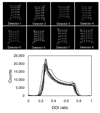A prototype PET scanner with DOI-encoding detectors
- PMID: 18552140
- PMCID: PMC2662710
- DOI: 10.2967/jnumed.107.049791
A prototype PET scanner with DOI-encoding detectors
Abstract
Detectors with depth-encoding allow a PET scanner to simultaneously achieve high sensitivity and high spatial resolution.
Methods: A prototype PET scanner, consisting of depth-encoding detectors constructed by dual-ended readout of lutetium oxyorthosilicate (LSO) arrays with 2 position-sensitive avalanche photodiodes (PSAPDs), was developed. The scanner comprised 2 detector plates, each with 4 detector modules, and the LSO arrays consisted of 7 x 7 elements, with a crystal size of 0.9225 x 0.9225 x 20 mm and a pitch of 1.0 mm. The active area of the PSAPDs was 8 x 8 mm. The performance of individual detector modules was characterized. A line-source phantom and a hot-rod phantom were imaged on the prototype scanner in 2 different scanner configurations. The images were reconstructed using 20, 10, 5, 2, and 1 depth-of-interaction (DOI) bins to demonstrate the effects of DOI resolution on reconstructed image resolution and visual image quality.
Results: The flood histograms measured from the sum of both PSAPD signals were only weakly depth-dependent, and excellent crystal identification was obtained at all depths. The flood histograms improved as the detector temperature decreased. DOI resolution and energy resolution improved significantly as the temperature decreased from 20 degrees C to 10 degrees C but improved only slightly with a subsequent temperature decrease to 0 degrees C. A full width at half maximum (FWHM) DOI resolution of 2 mm and an FWHM energy resolution of 15% were obtained at a temperature of 10 degrees C. Phantom studies showed that DOI measurements significantly improved the reconstructed image resolution. In the first scanner configuration (parallel detector planes), the image resolution at the center of the field of view was 0.9-mm FWHM with 20 DOI bins and 1.6-mm FWHM with 1 DOI bin. In the second scanner configuration (detector planes at a 40 degrees angle), the image resolution at the center of the field of view was 1.0-mm FWHM with 20 DOI bins and was not measurable when using only 1 bin.
Conclusion: PET scanners based on this detector design offer the prospect of high and uniform spatial resolution (crystal size, approximately 1 mm; DOI resolution, approximately 2 mm), high sensitivity (20-mm-thick detectors), and compact size (DOI encoding permits detectors to be tightly packed around the subject and minimizes number of detectors needed).
Figures







Similar articles
-
Depth of interaction calibration for PET detectors with dual-ended readout by PSAPDs.Phys Med Biol. 2009 Jan 21;54(2):433-45. doi: 10.1088/0031-9155/54/2/017. Epub 2008 Dec 19. Phys Med Biol. 2009. PMID: 19098356 Free PMC article.
-
Experimental characterization and system simulations of depth of interaction PET detectors using 0.5 mm and 0.7 mm LSO arrays.Phys Med Biol. 2009 Jul 21;54(14):4605-19. doi: 10.1088/0031-9155/54/14/015. Epub 2009 Jun 30. Phys Med Biol. 2009. PMID: 19567945 Free PMC article.
-
Development of depth encoding small animal PET detectors using dual-ended readout of pixelated scintillator arrays with SiPMs.Med Phys. 2018 Feb;45(2):613-621. doi: 10.1002/mp.12722. Epub 2017 Dec 30. Med Phys. 2018. PMID: 29222959
-
Effects of system geometry and other physical factors on photon sensitivity of high-resolution positron emission tomography.Phys Med Biol. 2007 Jul 7;52(13):3753-72. doi: 10.1088/0031-9155/52/13/007. Epub 2007 May 29. Phys Med Biol. 2007. PMID: 17664575 Free PMC article.
-
Recent developments in PET detector technology.Phys Med Biol. 2008 Sep 7;53(17):R287-317. doi: 10.1088/0031-9155/53/17/R01. Epub 2008 Aug 11. Phys Med Biol. 2008. PMID: 18695301 Free PMC article. Review.
Cited by
-
Crystal identification in positron emission tomography using nonrigid registration to a Fourier-based template.Phys Med Biol. 2008 Sep 21;53(18):5011-27. doi: 10.1088/0031-9155/53/18/011. Epub 2008 Aug 22. Phys Med Biol. 2008. PMID: 18723924 Free PMC article.
-
Tapered LSO arrays for small animal PET.Phys Med Biol. 2011 Jan 7;56(1):139-53. doi: 10.1088/0031-9155/56/1/009. Epub 2010 Nov 30. Phys Med Biol. 2011. PMID: 21119228 Free PMC article.
-
Depth of Interaction Calibration and Capabilities in 2×2 Discrete Crystal Arrays and Digital Silicon Photomultipliers.IEEE Trans Nucl Sci. 2016 Feb;63(1):4-7. doi: 10.1109/tns.2015.2498524. Epub 2016 Feb 15. IEEE Trans Nucl Sci. 2016. PMID: 32063651 Free PMC article.
-
Continuous depth-of-interaction encoding using phosphor-coated scintillators.Phys Med Biol. 2009 Mar 21;54(6):1757-71. doi: 10.1088/0031-9155/54/6/023. Epub 2009 Mar 3. Phys Med Biol. 2009. PMID: 19258685 Free PMC article.
-
Physical effects of mechanical design parameters on photon sensitivity and spatial resolution performance of a breast-dedicated PET system.Med Phys. 2010 Nov;37(11):5838-49. doi: 10.1118/1.3484059. Med Phys. 2010. PMID: 21158296 Free PMC article.
References
-
- Cherry SR, Shao Y, Silverman RW, et al. MicroPET: A high resolution PET scanner for imaging small animals. Ieee Transactions on Nuclear Science. 1997 Jun;44(3):1161–1166.
-
- Lecomte R, deKemp RA, Klein R, et al. LabPETtm: A second-generation APD-based digital scanner for high-resolution small animal PET imaging. Medical Physics. 2006 Jul;33(7):2671–2671.
-
- Missimer J, Madi Z, Honer M, Keller C, Schubiger A, Ametamey SM. Performance evaluation of the 16-module quad-HIDAC small animal PET camera. Physics in Medicine and Biology. 2004 May;49(10):2069–2081. - PubMed
-
- Surti S, Karp JS, Perkins AE, et al. Imaging performance of A-PET: A small animal PET camera. Ieee Transactions on Medical Imaging. 2005 Jul;24(7):844–852. - PubMed
Publication types
MeSH terms
Substances
Grants and funding
LinkOut - more resources
Full Text Sources
Other Literature Sources
